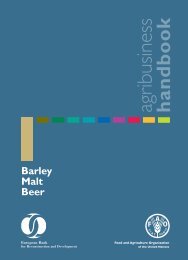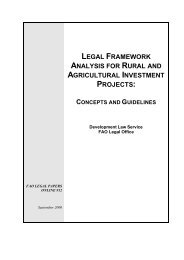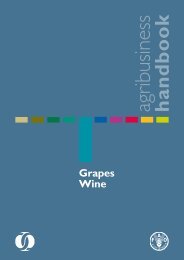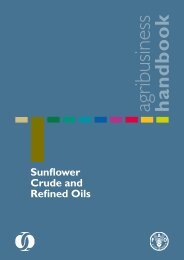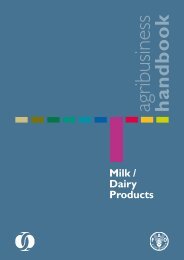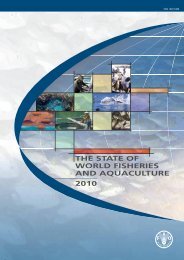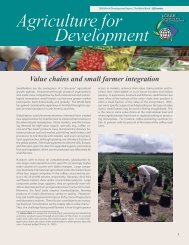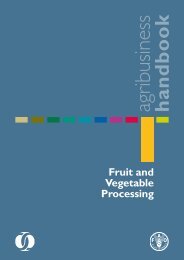Foreign Direct Investment (FDI) in Land in developing countries
Foreign Direct Investment (FDI) in Land in developing countries
Foreign Direct Investment (FDI) in Land in developing countries
- No tags were found...
You also want an ePaper? Increase the reach of your titles
YUMPU automatically turns print PDFs into web optimized ePapers that Google loves.
37Legal domestic environmentIn Mali, the land tenure system is based on theCode Domanial et Foncier (CDF, <strong>Land</strong> Act) 17 , theLoi d’Orientation Agricole (LOA, AgriculturalOrientation Law), the Code Forestier, (Forest Act)and the Charte Pastorale (Law on Pastoralism) aswell as its implement<strong>in</strong>g provisions. They providethe follow<strong>in</strong>g four property categories:• National Doma<strong>in</strong> (cover<strong>in</strong>g the entire Malianterritory),• State public land,• State private land, and• Private land.In accordance with the French system, state landis divided <strong>in</strong>to state public and state private land.While state public land comprises all lands withpublic functions (natural and artificial doma<strong>in</strong>s),state private land covers all other areas which arenot under private ownership. State private landcan be registered under the name of a legal entity(such as a state enterprise, a foreign <strong>in</strong>vestor etc.)or be unregistered.Neither communal nor <strong>in</strong>digenous land is knownas such <strong>in</strong> Mali. Areas where local people possesscustomary land rights are <strong>in</strong>cluded <strong>in</strong> the stateprivate doma<strong>in</strong>, hence considered to be state privatelands. They are only recognised and partiallysecured if they are located <strong>in</strong> unregistered areas.They rema<strong>in</strong> secured as long as common public<strong>in</strong>terest does not call for a different use. In thiscase, however, customary rights need to becompensated. In practice, this is only done forcustomary owners who can present written proof.Although customary rights are recognised onunregistered lands, they are considered to be userights only. Officially, they cannot be sold. In caseof compensation, not the land, only the addedvalue <strong>in</strong> form of constructions, cultures etc. iscompensated. It is, however, possible for a holderof a customary right to change it <strong>in</strong>to a formalright – first a provisional concession and then atitle – if he or she follows a rather long, drawn outand expensive procedure.CDF and LOA provide for the follow<strong>in</strong>g landtenure arrangement: annual contract, cultivationpermission, rural concession, leasehold, land title –all allocated by the state on (former) state privateland. The land title can be held only by nationalfarmers. <strong>Foreign</strong> operators are entitled to leasesonly. Most <strong>FDI</strong> contracts are based on a renewablelease of up to 50 years, respectively 99 years <strong>in</strong>total. Similar to the situation <strong>in</strong> Laos, problemsand conflicts arise from the fact that local farmers’and pastoralists’ land (use) rights are not (sufficiently)respected by the national <strong>in</strong>stitutions/representatives sign<strong>in</strong>g the <strong>FDI</strong> contracts. Most ofthe land <strong>FDI</strong> <strong>in</strong>vest<strong>in</strong>g <strong>in</strong> Mali has been given tothe Niger Office (a state enterprise irrigat<strong>in</strong>g amajor area along the river Niger, primarily for riceproduction) and has thus been registered as“registered land”. Hence, customary rights on thisland are not recognised although hundreds ofthousands of people live on these lands, farm theselands, graze their animals there, live from theforests and depend on the water available there.Additional national regulations oblige foreign<strong>in</strong>vestors to conduct an environmental and socialimpact assessment. In practice, however, these areoften not done or only after major constructionworks have already been started.Data on the size of <strong>FDI</strong> <strong>in</strong> land and risks andopportunitiesCurrently <strong>in</strong> Mali, 173,605 ha are known to bedemanded for foreign <strong>in</strong>vestments. In addition,there is <strong>in</strong>formation about an <strong>in</strong>vestment ofanother 200,000 ha by a Saudi Arabian company<strong>in</strong> food <strong>in</strong> Mali (Gra<strong>in</strong>). This <strong>in</strong>formation couldnot been verified yet.Most of the <strong>in</strong>vestment is tak<strong>in</strong>g place <strong>in</strong> theNiger Office Area. This is the most fertile area ofMali with production depend<strong>in</strong>g on irrigationfrom the Niger River. But s<strong>in</strong>ce water availabilitydur<strong>in</strong>g the dry season is limited, only 250,000 haare irrigable. Therefore, further demand <strong>in</strong> landand water will create water conflicts. The case ofMalibya, currently <strong>in</strong> the implementation projectphase of build<strong>in</strong>g roads and dams, is alreadyresult<strong>in</strong>g <strong>in</strong> conflicts with cattle breeders, s<strong>in</strong>cetheir traditional routes and graz<strong>in</strong>g areas areignored. Whereas Malibya is exclusively produc<strong>in</strong>gfor the Libyan market with the objective to securefood security <strong>in</strong> Libya and to reduce dependencyon food imports and therefore on the food world17 Ord<strong>in</strong>ance n° 00-27/P-RM of Mars 22 2000, named “Code domanial et Foncier” (<strong>Land</strong> Act) modified by the Law n° 02-008 of February 12 2002.



